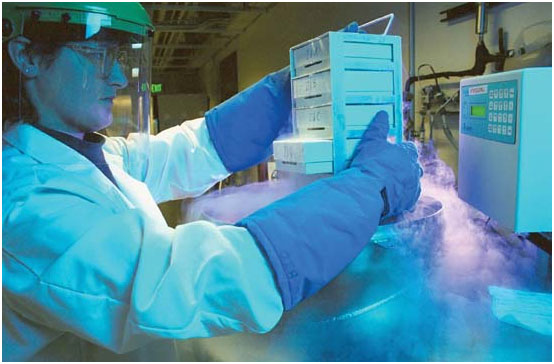Cell phone:+8617329375552
TEL:+86-373-5871333
P.C:453000
E-mail: info@jxcryo.com
Add: Chenbao Industrial Park,Xinxiang City,Henan Province,China.

- +8617329375552
Cryopreservation, the preservation of cells and tissue by freezing

A technician withdrawing deep-frozen cells for in vitro culture.
Cryopreservation is based on the ability of certain small molecules to enter cells and prevent dehydration and formation of intracellular ice crystals, which can cause cell death and destruction of cell organelles during the freezing process.
Cryopreservation is the process of freezing biological material at extreme temperatures; most common -196 °C/-321 °F in liquid nitrogen (N2). At these low temperatures, all biological activity stops, including the biochemical reactions that lead to cell death and DNA degradation. This preservation method in theory makes it possible to store living cells as well as other biological material unchanged for centuries.
The challenge of cryopreservation is to help cells to survive both cooling to extreme temperatures and thawing back to physiological conditions. Intracellular ice formation in particular is a critical issue that has to be controlled to keep the cell membrane intact and the cells alive. The crucial elements to prevent this are the freezing rate (degrees per minute) and the composition of the freezing medium used. The freezing medium generally consists of a diluter, (sometimes) a protein source, as well as a cryoprotectant compound. The choice of most suitable cryoprotectant will influence the preservation result and will be different between different cells and different species.
Cryopreservation technology is important in breeding programs to preserve desired genes, but also provides an opportunity to save endangered species.
Embryo Cryopreservation
Embryo freezing preserves embryos by cooling and storing them at low temperatures. They can be thawed later and transferred to the uterus, providing additional opportunities for conception.
During the in vitro fertilization (IVF) process, multiple eggs are stimulated to grow, then recovered from the ovary and fertilized. This may result in more embryos or fertilized eggs than a couple wants at one time. If the additional embryos are of sufficiently good quality to undergo freezing, they can be used later if the first IVF isn't successful. If the IVF is successful, the extra embryos can be stored for several years to be used if the couple decides to have more children. UCSF stores embryos with an annual agreement.
With these embryos, UCSF has achieved pregnancies after as many as five years of storage, and has a pregnancy rate that is almost identical to that of fresh embryos. Worldwide, embryo freezing is a successful procedure with no reports of increased birth defects.
Semen Cryopreservation
Ejaculated sperm or sperm obtained from fluid extracted during surgical procedures (vasal, epididymal and testicular sperm specimens) can be frozen. The sperm is usually frozen for one year. Longer term storage can be arranged after the first year. Thawed sperm are no more likely to result in birth defects than freshly ejaculated sperm.







